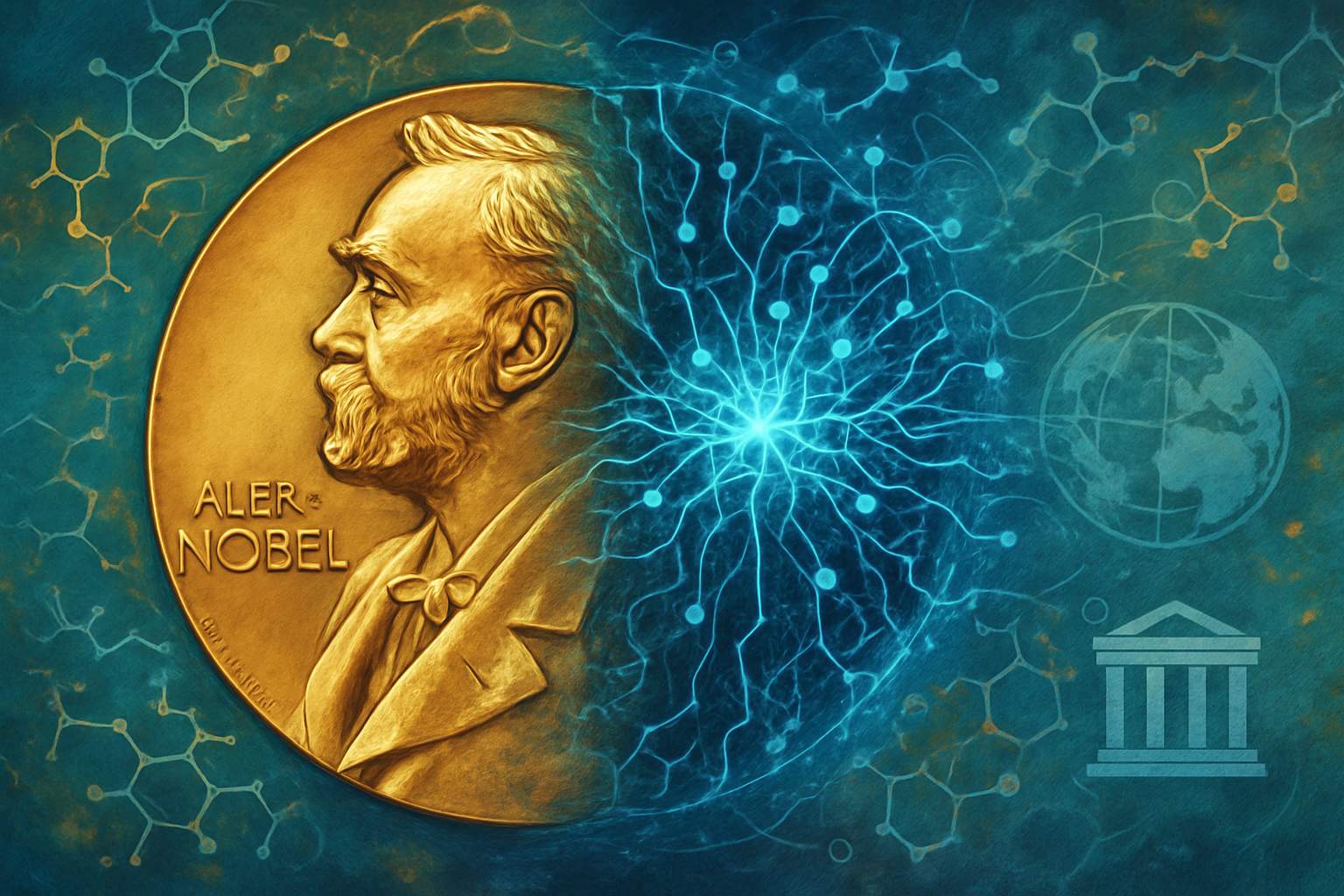
AI CERTS
5 hours ago
AI scientific breakthrough validation after AlphaFold Nobel
Moreover, we track the protein folding revolution from early experiments to global adoption. Secondary themes include the compounding intelligence effect and expected Nobel Chemistry 2025 ripples. Consequently, readers gain a strategic view of ongoing research transformation. Let us begin with prize context.
Nobel Prize Contextual View
The Royal Swedish Academy split the 2024 honour between David Baker and DeepMind leaders. Baker received half for protein design, while Hassabis and Jumper shared the prediction half. Linke, chair of the committee, called structure prediction a fulfilled fifty-year dream. Consequently, AlphaFold’s database of 200 million predicted proteins gained historic legitimacy overnight. Meanwhile, official materials reported more than two million global users across 190 countries. Such adoption illustrates rapid AI scientific breakthrough validation in practice. Nevertheless, the prize also sparked debate over industrial influence on laureate selection.

- Nature counts over 30,000 AlphaFold-related papers worldwide.
- The public database serves more than two million users from 190 countries.
- Independent studies rate 35% predictions very accurate and another 45% broadly usable.
In summary, Nobel validation raised AlphaFold’s profile and quantitative reach. However, technical progress drives the narrative forward.
AlphaFold Technical Advances Unveiled
AlphaFold evolved through three versions, each expanding predictive scope. CASP14 performance in 2020 demonstrated near experimental accuracy for many proteins. Furthermore, AlphaFold2 released open code and weights, seeding community trust. Subsequently, AlphaFold3 modelled complexes with DNA, RNA, and ligands. Initial AF3 release restricted weights, limiting reproducibility and hampering AI scientific breakthrough validation discussions. In contrast, DeepMind later offered academic access after sustained criticism. Community developers responded by launching open reproductions like ColabFold. These efforts underline the protein folding revolution through shared tooling. Moreover, iterative improvements illustrate the compounding intelligence effect within model development. Therefore, technical milestones set the stage for wider biological applications.
AlphaFold’s trajectory shows accelerating capability and ongoing openness tension. Consequently, attention shifts towards impact across research.
Impact Across Research Fields
Researchers have downloaded billions of structure files from the public database. Consequently, tens of thousands of publications reference AlphaFold data. Drug discovery teams exploit predictions to rank targets and design candidates faster. Meanwhile, enzyme engineers optimize plastic-degrading enzymes, illustrating tangible environmental gains. Several start-ups raised large rounds to translate outputs into therapies. Such achievements confirm the protein folding revolution across sectors. Moreover, many observers label this wave a compounding intelligence effect at the ecosystem level. Consequently, forecasts suggest additional Nobel Chemistry 2025 recognition for downstream innovators.
- Nature counts over 30,000 AlphaFold-related papers worldwide.
- The public database serves more than two million users from 190 countries.
- Independent studies rate 35% predictions very accurate and another 45% broadly usable.
These metrics showcase immediate research transformation and commercial traction. However, openness questions still dominate discussion. Further AI scientific breakthrough validation appears through replicated drug lead predictions in independent pipelines.
Openness Versus Commercialization Debate
AlphaFold2 embraced open licenses, fueling community tools. In contrast, AlphaFold3 launched with a gated server and restrictive terms. Critics argued that approach delayed AI scientific breakthrough validation by external groups. DeepMind responded by opening academic weights months later. Nevertheless, non-commercial clauses still hinder mixed academic-industry collaborations. Moreover, policy researchers warn of biosecurity and dual-use considerations. Meanwhile, alternative open models race ahead, challenging proprietary dominance. Consequently, the protein folding revolution also becomes a licence battlefield. Stakeholders seek equilibrium between commercialization incentives and collective research transformation. Therefore, governance choices today may influence Nobel Chemistry 2025 deliberations.
Debates underscore the field’s social dimension beyond algorithms. Subsequently, scientists revisit technical limitations with renewed urgency.
Persistent Scientific Limitations Discussed
AlphaFold delivers static snapshots, not dynamic conformational ensembles. Therefore, experimental validation remains essential for binding affinities, disordered regions, and post-translational modifications. Robust AI scientific breakthrough validation still relies on cross-lab blind tests like CASP. Independent benchmarks place very accurate predictions at roughly 35% of the database. Moreover, pLDDT confidence scores guide users yet demand careful interpretation. In contrast, early AlphaFold3 multimer results show promise for complexes but still need replication. Critics suggest the compounding intelligence effect may plateau without new experimental data. Nevertheless, academic groups collect fresh cryo-EM structures to feed future models. Consequently, sustainable progress requires coordinated lab and compute investments.
Technical gaps remind stakeholders that AI tools complement, not replace, wet lab science. Meanwhile, attention shifts toward governance and future recognition.
Future Roadmap And Governance
Next milestones include broader ligand affinity prediction and ensemble modeling initiatives. Furthermore, DeepMind spinout Isomorphic Labs aims to push candidates into clinics. Pharma collaborators anticipate accelerated timelines, illustrating ongoing research transformation at scale. Some observers forecast another award, tagged unofficially Nobel Chemistry 2025, for applied breakthroughs. Moreover, policymakers debate open-access mandates, safety frameworks, and equitable data sharing. Subsequently, professional development becomes vital for talent readiness. Professionals can enhance their expertise with the AI Researcher™ certification. Such courses support rigorous AI scientific breakthrough validation across future projects. Consequently, skill pipelines complement technological progress.
Commercial Spinout Momentum Builds
Isomorphic Labs closed significant rounds, while Latent Labs and others follow. Furthermore, big-pharma partnerships test AlphaFold-driven pipelines in oncology and rare diseases. Consequently, the compounding intelligence effect amplifies funding feedback loops. Nevertheless, investors now demand clear AI scientific breakthrough validation before committing phase-two capital. These market pressures incentivize transparent benchmarks and open source comparisons.
Governance, talent, and investment will determine the next decade’s trajectory. Therefore, monitoring policy outcomes enables proactive strategy.
AlphaFold’s Nobel spotlight symbolises a turning point for AI and molecular science. However, openness disputes and technical gaps prove the journey remains unfinished. Continued experimental collaboration will strengthen AI scientific breakthrough validation metrics. Moreover, the protein folding revolution now influences funding, policy, and education. Stakeholders should track the compounding intelligence effect as models iterate and data expands. Consequently, upcoming innovations may set the stage for Nobel Chemistry 2025 recognition. Finally, readers can accelerate their own research transformation by acquiring relevant certifications and joining open collaborations. Explore the linked AI Researcher program and stay prepared for the next era. Innovation progresses fastest when validation, transparency, and community move together.



